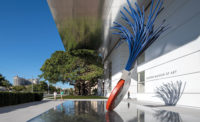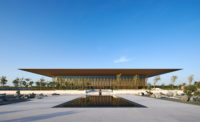At a press preview of the February 9th reopening of the Norton Museum of Art in West Palm Beach, Florida, Norman Foster explained how he decided to change the entrance of the institution in his firm’s design for a new addition and renovation.
While visiting the existing museum in 2013, he went up to what should have been the front door on the main thoroughfare—and saw a sign that read “Oops! This is not an entrance. Please follow the sidewalk to the south-facing entrance.”
Thus, in moving the entrance to the front, Foster and his team restored the original east-west axis that now links the new entrance to the rear courtyard and a view of the Intracoastal Waterway. The new stucco-clad wing that fronts the museum is topped by huge metal letters on the roof that announce the name to anyone driving down South Dixie Highway. But the defining feature of the facade is a 43-foot-high canopy of polished aluminum, cut in a razor-sharp curve to accommodate an enormous 80-year-old Banyan tree that Foster describes as “the protagonist” of the entire project.
The extension also wraps around the south side of the former building; overall, the new spaces in the museum include a restaurant, a special events room, a 210-seat auditorium, and a dramatic 3,600-square-foot “Great Hall” (the living room of the museum with grand piano, Eames/Saarinen lounge chairs, a coffee bar, and bookstand), featuring a spectacular oculus tucked into a 43-foot-high coved ceiling, which appears to float over the room. The existing galleries have been elegantly renovated, with their original wooden floors revealed, and the overall circulation of the museum has been clarified.
The glass wall (designed to withstand 175-mph hurricane winds) of a new sculpture gallery along the side overlooks a simple, intimate garden, part of the first institutional landscape that Foster + Partners has designed. (Boston-based CBT served as executive architect.)
The new construction and substantially renovated spaces add up to 59,000 square feet, out of what is now a total of 133,000 square feet, with 12,000 square feet of additional galleries. And the second phase of the architects’ original 20-year master plan for the museum is beginning.
“As an architect, it’s fantastic when you get a green site,” said Foster, who was deeply involved in this project, “but it’s equally interesting and perhaps more challenging to take old buildings and bring a sense of cohesion, order, and clarity to them.”


















Post a comment to this article
Report Abusive Comment